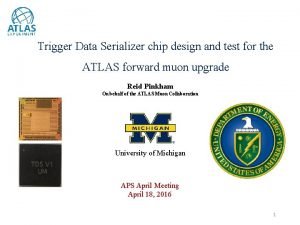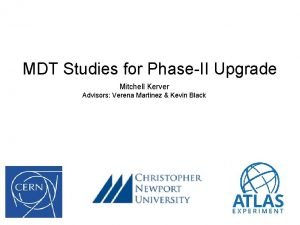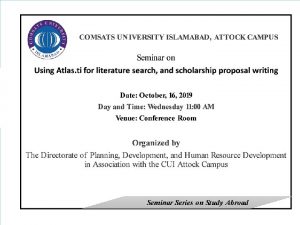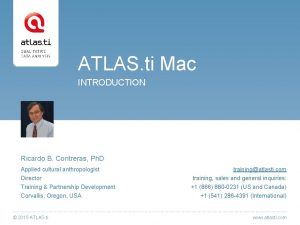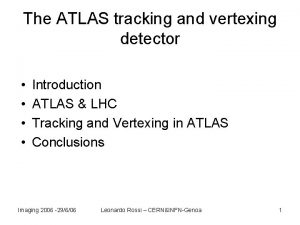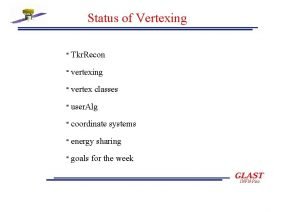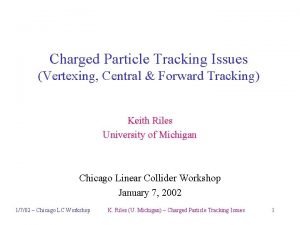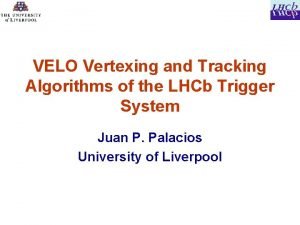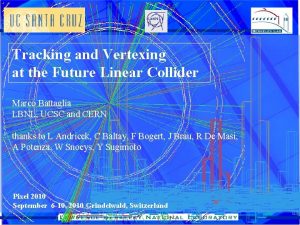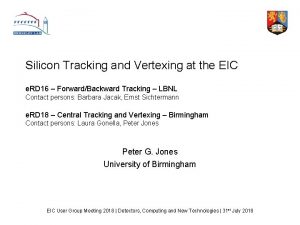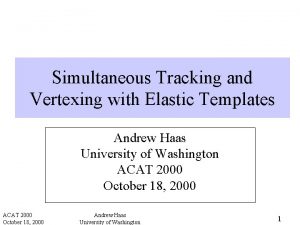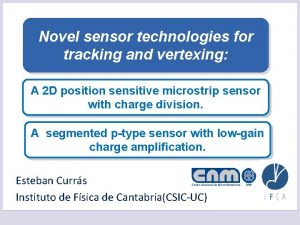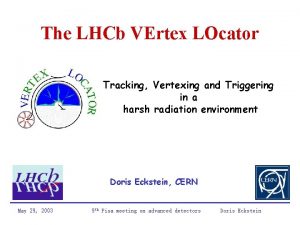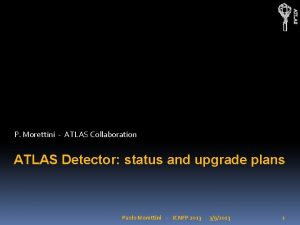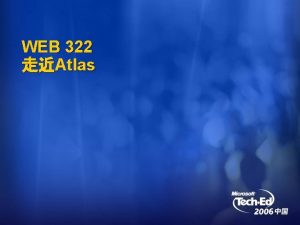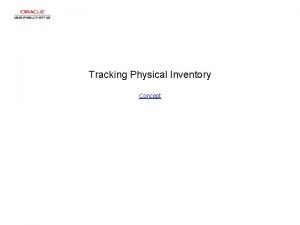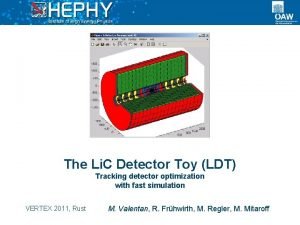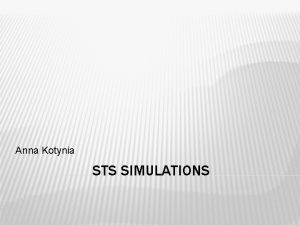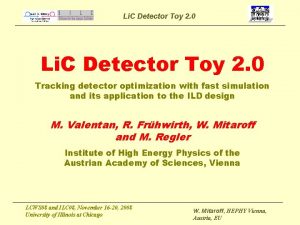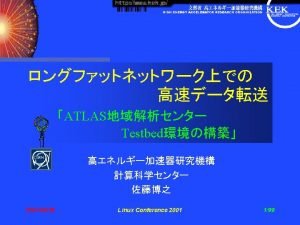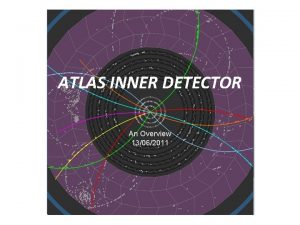The ATLAS tracking and vertexing detector Introduction ATLAS


























- Slides: 26

The ATLAS tracking and vertexing detector • • Introduction ATLAS & LHC Tracking and Vertexing in ATLAS Conclusions Imaging 2006 -29/6/06 Leonardo Rossi – CERN&INFN-Genoa 1

Particle physics and imaging • one hit pattern (image) = trails left by ionizing particles = 1 event • one image is made of many events (e. g. many X-ray conversions) • Information concentrated in some special events (to be hunted for) • Information distributed in all events • Interesting events must be selected (trigger + analysis) Imaging 2006 -29/6/06 • Summing-up enough events give the required image quality Leonardo Rossi – CERN&INFN-Genoa 2

Higher energies & luminosities • Particle physics trends higher energies (nb) • explore smaller details of the matter (l=h/p) • have access to higher masses (E=mc 2) but also higher interaction rate (= machine luminosity) • The events of interest (higher mass) are rare • …and “buried” Imaging 2006 -29/6/06 m Leonardo Rossi – CERN&INFN-Genoa ¥, ho tu niv ers e , t 0 3

• The most economic way of getting high-E and L is p-p collisions • protons are complex objects: • Only hard collisions are useful • A lot of background collisions • Effective energy available: =Ö X 1 X 2 E 2 • wide band energy beams – useful to explore new E-window • few energetic collisions – need to select them X 2 X 1 Imaging 2006 -29/6/06 Leonardo Rossi – CERN&INFN-Genoa 4

Tracking at LHC • Large Hadron Collider in operation next year • Circumf ~27 km, E=14 Te. V, L=1034 cm-2 s-1, 40 MHz x-ing • 1 GHz interaction rate, 103 particles each 25 ns. • Tracking detectors must then be: • Fast (40 MHz), Rad-Hard (10 -100 k. Gy), high granularity & good pattern recognition capabilities (103 tks/25 ns). • Environment is hostile, why measuring tracks? • To measure momenta ( dynamics, invariant masses) • To measure vertices » Primary improve on p and E measurements » Secondary tag ps living particles (b, t) markers of events with significant physics content • To help identifying photons Imaging 2006 -29/6/06 Leonardo Rossi – CERN&INFN-Genoa 5

ATLAS tracking • General guidelines of ATLAS tracker design • Outer shell R[56 -108 cm] continuous tracking (~30 hits per track) with closely packed gaseous detectors (Transition. Radiation. Tracker) • Inner shell R[5 -60 cm] discrete tracking with higher precision silicon detectors » Outside microstrip detectors (Sili. Con. Tracker) » Inside pixel detectors (Pixel) (higher granularity and radiation hardness) • Let’s flash trough ATLAS and then concentrate on tracking and vertexing Imaging 2006 -29/6/06 Leonardo Rossi – CERN&INFN-Genoa 6

The ATLAS Detector Magnet system ( 2 Tesla) Muon Spectrometer Calorimeter Inner Detector = Tracker Imaging 2006 -29/6/06 Leonardo Rossi – CERN&INFN-Genoa 7

End Cap TRT Barrel TRT End Cap SCT ~2. 2 m Pixels ~5. 5 m Inside a 2 T solenoidal B-field The ATLAS Tracker Barrel SCT • Layout is split in 4 parts (installed separately): • Barrel (SCT+TRT): cylindrical geometry • 2 Forward Sections ( both SCT+TRT): disk geometry • Pixel (+ beam-pipe) (cylindrical + disk geometry) acceptance: -2. 5<h<2. 5 Imaging 2006 -29/6/06 Leonardo Rossi – CERN&INFN-Genoa h=-ln tan(q/2) q=azimuth 8

The Tracking Detectors (inside out) Pixel: Barrel: 3 layers (R=5. 1, 8. 9, 12. 3 cm). Endcap: 2 x 3 disks of Silicon pixel detectors (Rin=9, Rout=15 cm) cm Building block: the module (1744 all equal, 13 0 covering 1. 7 m 2, 46080 channels each (then 80 106 channels), 250 mm thick, pitch 50 x 400 mm) 60. 8 mm Top view Side view - sketch (not to scale) 16. 4 mm Imaging 2006 -29/6/06 Leonardo Rossi – CERN&INFN-Genoa 0. 2 mm thick sensor 16 front-end chips 9

Working principle: ionization in small volume (0. 05 x 0. 4 x 0. 2 mm 3) Si. All volumes contiguous (full surface sensitive). Electronics matrix matches sensor matrix connection out-of-plane (bump bonding) Advantages: small C (good S/N, fast), small I + can operate partially depleted (rad-hardness), excellent PR capability Drawbacks: cost/cm 2, power density Imaging 2006 -29/6/06 Leonardo Rossi – CERN&INFN-Genoa 10

Key ATLAS Pixel Results Efficiency after 500 k. Gy Time resolution vs charge signal e = 98. 7± 0. 7% (0 k. Gy 99. 9%) Plateau =9. 7± 1. 1 ns (0 k. Gy 14 ns) Imaging 2006 -29/6/06 Leonardo Rossi – CERN&INFN-Genoa 11

Space resolution 500 k. Gy =9. 7 m 0 k. Gy =7. 5 m only binary readout Imaging 2006 -29/6/06 Leonardo Rossi – CERN&INFN-Genoa 12

SCT: Barrel: 4 cylinders (R~30 , 37, 44 and 51 cm) End. Cap: 9 disks per side (Rin-min~27, Rout~56 cm) 9 disks 4 cylinders 12 cm 40 m. Rad stereo Building block: the module (back-to-back single sided Si microstrip sensors 285 mm thick, 80 mm pitch). 2112(b)+1976(ec) modules Imaging 2006 -29/6/06 Leonardo Rossi – CERN&INFN-Genoa 6 cm covering 61 m 2 with 6. 2 106 channels. Barrel module 13

Working principle: same as for Pixel, connectivity simpler (ASIC connected with wire bonding), does not provide 3 D information • All Si detectors in ATLAS must run cold (-5 ºC) to maximize lifetime under irradiation: • dry N 2 environment • powerful cooling systems (Pixel: ~1 W/cm 2, SCT~0. 1 W/cm 2) • Key ATLAS SCT results • only 0. 2% of the strips are bad (final system) <noise>~1600 e- <noise occupancy> = 4 x 10 -5 @ 1 f. C Imaging 2006 -29/6/06 Leonardo Rossi – CERN&INFN-Genoa 14

TRT: Barrel: 36 layers of 4 mm straws parallel to B (56<R<108 cm, L=143 cm) End. Cap: 160 layers (=14 wheels) perp to B. m c 3 14 Building block: the straw (~3 105 channels) Proportional counter, Ø=4 mm, 30 mm wire working at G~2 104 Radiator foil 70% Xe, 27% CO 2, 3% O 2 Imaging 2006 -29/6/06 Leonardo Rossi – CERN&INFN-Genoa 15

Key ATLAS TRT Results Electrons vs pions Resolution and efficiency Scan across the Barrel =135 m Noise occupancy ~2% over 75 ns Imaging 2006 -29/6/06 Leonardo Rossi – CERN&INFN-Genoa 16

Status: putting parts together (Barrel) Barrel TRT Barrel SCT Imaging 2006 -29/6/06 Leonardo Rossi – CERN&INFN-Genoa 17

and making them work together The same exercise has now to be repeated with the two End Caps and the Pixel, while we will be installing the Barrel inside ATLAS (see inner magnet cryostat bore with cables & pipes) Imaging 2006 -29/6/06 Leonardo Rossi – CERN&INFN-Genoa 18

Tracking & vertexing performance (simulation) • Key parameter are the number of measurements and their precision points s (Rf) (mm) s (z) (mm) • then knowledge of Pixel 3 10 60 the B-field and of the 4 17 580 material crossed must SCT TRT 38 140 be used in the track propagation Measured values This is 1 track out of ~103 in the event. Often grouped in “jets” Imaging 2006 -29/6/06 Leonardo Rossi – CERN&INFN-Genoa 19

• Track reconstruction efficiency e~98%, fake rate 0. 3% 2% (less in barrel) for p. T>1 Ge. V/c tracks) • Momentum measurement allows to distinguish +ve/-ve particles up to 1 Te. V in most of the acceptance (1/p. T) vs h • One important goal of the tracker is to find tracks missing primary vertex as they may come from short living particle decays (d 0~ct for b 1, t=lifetime 1 ps lifetime t = 300 mm impact parameter d 0). • The impact parameter resolution ( (d 0)) is therefore a very important parameter. Imaging 2006 -29/6/06 Leonardo Rossi – CERN&INFN-Genoa 20

(d 0) vs h • …and it should be sensibly less than 300 mm (ok for p. T h) • multiple scattering contributions become dominant for low momentum tracks: s(d 0)= 10Å60/(p. T Ösin. Q) mm but still allows to use all tracks above 1 Ge. V x(z)=transverse (long. ) to the beam • Vertex reconstruction done using 3 D tracks and error matrices and rejecting tracks giving too large a c 2 contribution. First fit around the beam (known to better than 0. 1 mm) to look for primary vertices. Imaging 2006 -29/6/06 Leonardo Rossi – CERN&INFN-Genoa (x)=11 m (s(z)=45 mm) 21

• All events contain “jets” of particles, we should then discriminate if inside the jet there has been a decay or not • With vertex position and track impact parameter known to 10 mm we are now in position to discriminate if O[300] mm i. p. tracks are inside a particle jet. • Events rich in “impact parameter tacks” are likely to be rich in “ 1 ps particles” (i. e. b-hadrons and t –leptons). These are powerful indicators of events of interest, they need then to be selected out of the majority of events (light quark events). Soft lepton Jet axis Secondary Vertex B a 0>0 a 0<0 Primary vertex y x Imaging 2006 -29/6/06 Leonardo Rossi – CERN&INFN-Genoa 22

• Selection can be based on: • summing-up all contributions of the normalize imp. parameter d 0/s(d 0) • reconstruction of secondary vertices • One example: selection of b-jet events All d 0 Imaging 2006 -29/6/06 Probability distribution (d 0) Leonardo Rossi – CERN&INFN-Genoa 23

Probability distribution (vertex) • Selectivity can be improved using 3 D vertex reconstruction • resulting in light-q jet rejection of 200 -700 for b-jet efficiency of 6050%. • this is good enough as close to hit the physics background (i. e. ratio light vs b-jets at LHC) Imaging 2006 -29/6/06 Leonardo Rossi – CERN&INFN-Genoa 24

Conclusions • ATLAS track and vertex detector is “on track” for first LHC collisions in 2007 • This project is a major scientific and technological endeavor as it has required hundreds of FTE’s for ~10 years • Measured characteristics are better than design specs, we then expect a significant contribution to the discovery potential of ATLAS at LHC. Imaging 2006 -29/6/06 Leonardo Rossi – CERN&INFN-Genoa 25

• we very much look forward to see images like this. • …but true not simulated Imaging 2006 -29/6/06 Leonardo Rossi – CERN&INFN-Genoa 26
 Txp100
Txp100 Atlas detector
Atlas detector Introduction to atlas.ti
Introduction to atlas.ti Introduction to atlas.ti
Introduction to atlas.ti Hát kết hợp bộ gõ cơ thể
Hát kết hợp bộ gõ cơ thể Frameset trong html5
Frameset trong html5 Bổ thể
Bổ thể Tỉ lệ cơ thể trẻ em
Tỉ lệ cơ thể trẻ em Chó sói
Chó sói Chụp tư thế worms-breton
Chụp tư thế worms-breton Bài hát chúa yêu trần thế alleluia
Bài hát chúa yêu trần thế alleluia Môn thể thao bắt đầu bằng từ đua
Môn thể thao bắt đầu bằng từ đua Thế nào là hệ số cao nhất
Thế nào là hệ số cao nhất Các châu lục và đại dương trên thế giới
Các châu lục và đại dương trên thế giới Công thức tiính động năng
Công thức tiính động năng Trời xanh đây là của chúng ta thể thơ
Trời xanh đây là của chúng ta thể thơ Mật thư anh em như thể tay chân
Mật thư anh em như thể tay chân Phép trừ bù
Phép trừ bù Phản ứng thế ankan
Phản ứng thế ankan Các châu lục và đại dương trên thế giới
Các châu lục và đại dương trên thế giới Thể thơ truyền thống
Thể thơ truyền thống Quá trình desamine hóa có thể tạo ra
Quá trình desamine hóa có thể tạo ra Một số thể thơ truyền thống
Một số thể thơ truyền thống Bàn tay mà dây bẩn
Bàn tay mà dây bẩn Vẽ hình chiếu vuông góc của vật thể sau
Vẽ hình chiếu vuông góc của vật thể sau Biện pháp chống mỏi cơ
Biện pháp chống mỏi cơ đặc điểm cơ thể của người tối cổ
đặc điểm cơ thể của người tối cổ
